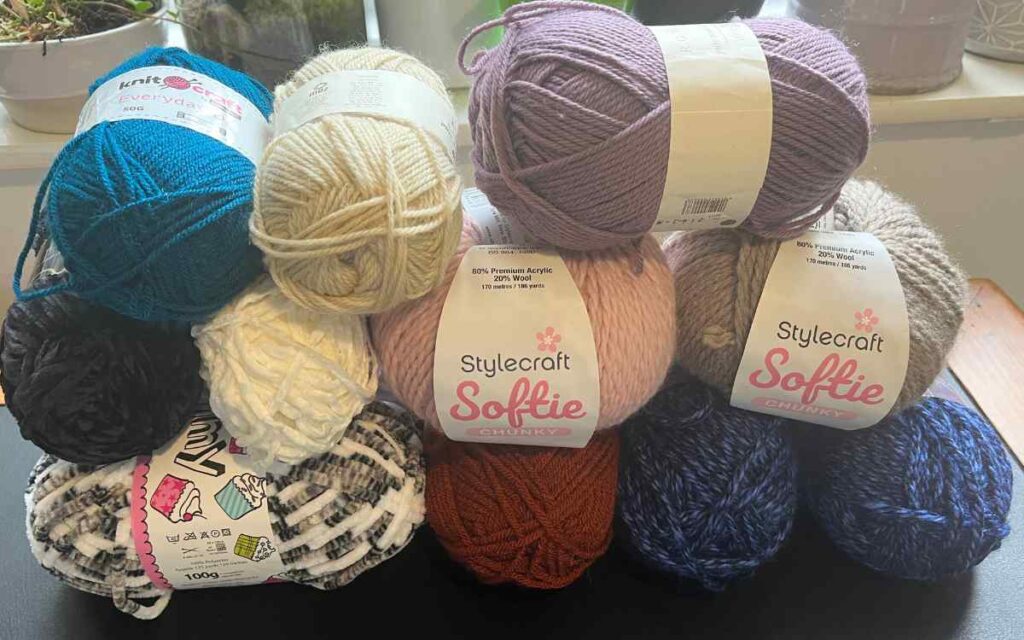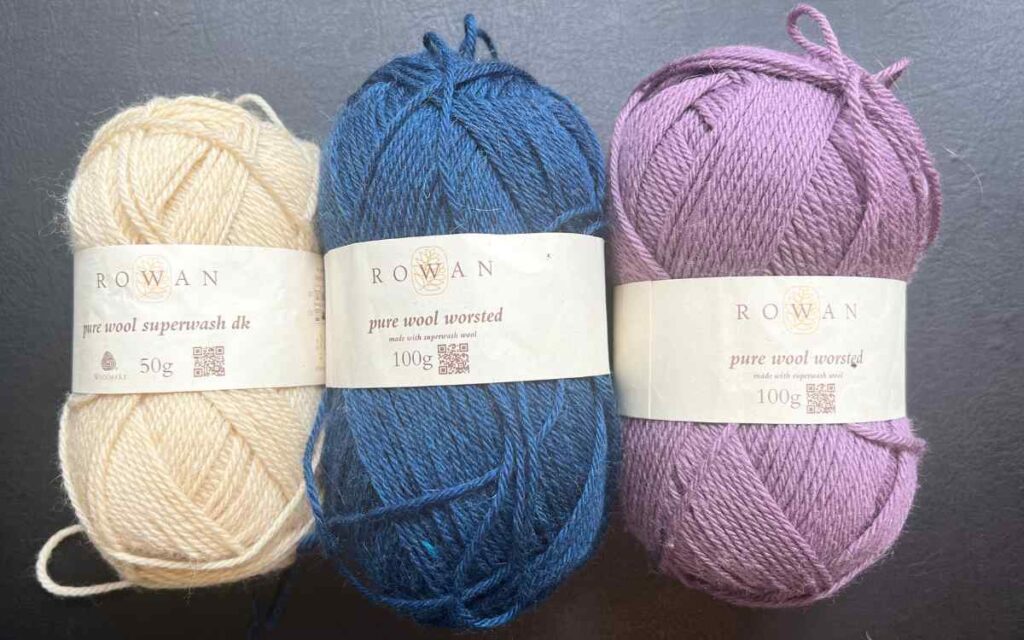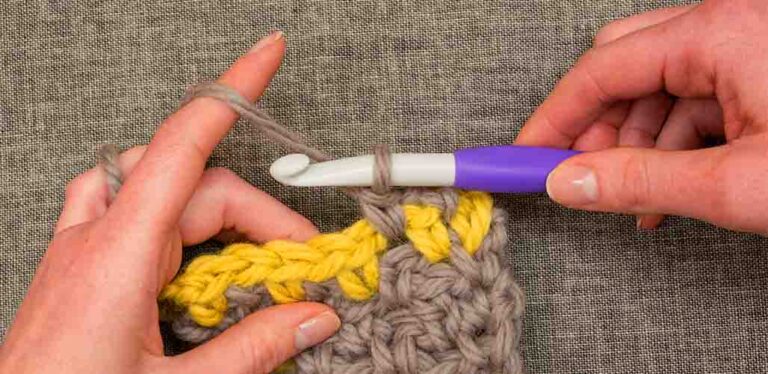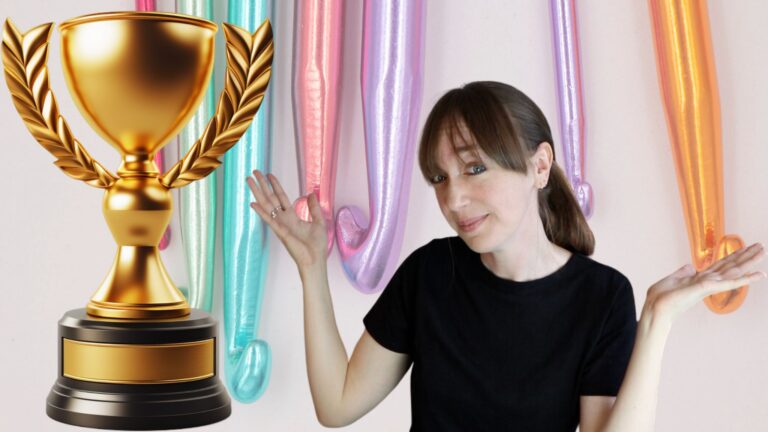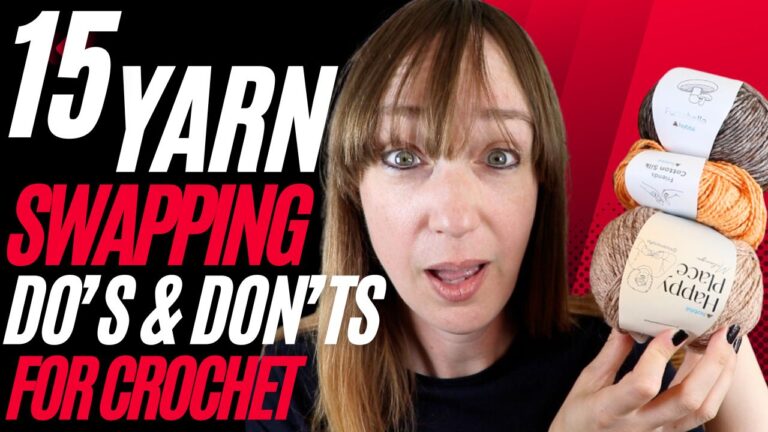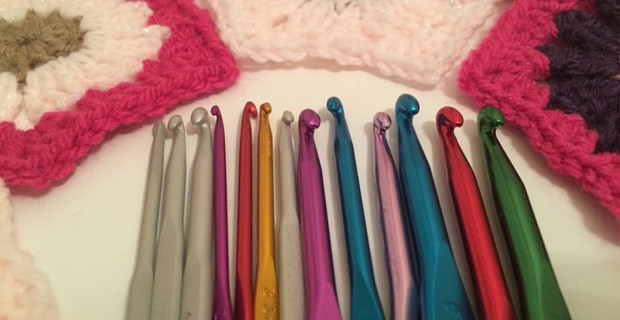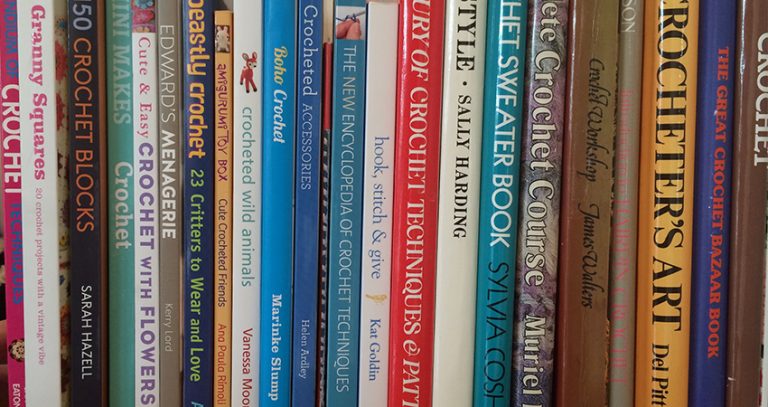Yarn For Crochet – Weights, Hooks and Styles
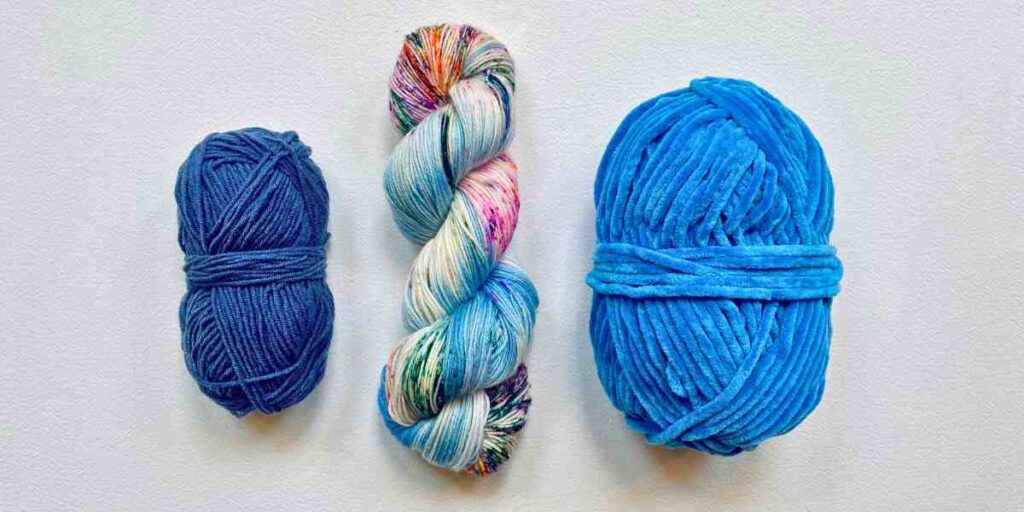
Yarn is a catch-all term for spun fiber. It’s basically any long stringy stuff that gets wound into a ball or skein, ready to crochet into fabulous things. Yarn is where crochet is born.
I have a bad habit of calling all yarns wool. Which is, of course, frequently incorrect. Natural wool from sheep, goats and alpacas can be turned into yarn, but so can acrylic, polyester, bamboo, cotton, linen and silk. And they can all be used for crochet!
If you’re new to crochet, or even just trying a new kind of project for the first time, choosing which yarn to buy can feel like a high stakes gamble. If the pattern doesn’t include directions about what yarn to use, how should you begin to choose? And if the pattern does recommend a specific yarn, how much does it matter if you can’t get hold of it, or don’t want to use it? Here’s our complete guide to choosing and using crochet yarns.
Want to know how to store your yarn in the best possible way? Jump over to this article!
Yarn 101
Yarns can be grouped by a variety of different properties:
- Fiber
- Weight
- Budget
- Texture
- Color/dye method
And you need to consider them in roughly that order. At each stage, you’ll make a decision about what’s most appropriate for your project, and that will narrow down your options a bit more. Just like applying filters to search results in an online shop! Eventually you’ll be left with a clear list of criteria, and probably just a handful of products to choose from, all of which should work equally well.
Step 1: Can you follow the yarn recommendation in the pattern?
If the pattern you’re following recommends using a particular type of yarn, you’ll achieve the most reliable results by sticking to that brief. Some patterns offer really specific yarn advice, and going along with that advice, if you can, certainly takes the head-scratching out of your choice. But what if it’s not available in your region, or outside your budget, or you don’t like the colors it comes in? The next best yarn you can use is one that has the same properties as the pattern-writer’s yarn. Three ways of finding that perfect dupe are:
- Use the filters on an online yarn retailer’s website to find yarns with the same properties.
- Put the name of the recommended yarn into yarnsub.com and let them do the legwork for you.
- Ask your knowledgeable local yarn store owner for suggestions.
Some patterns offer some advice about what yarn to use. For example they’ll say ‘using a DK yarn’, or ‘using a cotton yarn with a correctly sized hook’. In that scenario, the rest of this article will help you fill in the missing criteria and make a choice.
If you’re going to ignore any specific recommendations in the pattern, first think about why they were chosen in the first place. For example, a storage basket pattern which calls for cotton yarn will likely lose its structure if you replace it with acrylic. But you can play with different thicknesses of cotton yarn to achieve different sized baskets.
An important note about gauge
For garments, whenever you substitute one yarn for another, you should always make a swatch to check the gauge matches the pattern. Even between two yarns in the same weight category this won’t always be the case. If your gauge doesn’t match, try swapping to a crochet hook one size up, or down. For projects like blankets, scarves and amigurumi, achieving the exact same gauge is less important.
Step 2: What fiber to choose
Fiber means what a yarn is made out of. Common fibers used to make yarn include:
- Wool
- Acrylic
- Polyester
- Nylon
- Cotton
- Bamboo
- Linen
- Silk
There are lots of blended yarns on the market too, which harness the strengths of more than one fiber. Wool mixed with acrylic is an especially common blend: it’s more affordable than pure wool yarn, but warmer and holds its shape better than pure acrylic yarn.
Here’s an overview of the strengths and weakness of the popular yarn fibers:
Wool
Wool is the classic fiber for spinning yarn from – us humans have been at it for thousands of years. Natural wools can be made from the fleece of sheep, alpaca and goats (cashmere is a goat’s wool). And they have so many superior properties they’re almost magical – they’re warm, soft, durable, antistatic, moisture wicking, odor and dirt repelling, flame retardant, and hold their shape well.
In the past, some crocheters were put off wool because it needed gentle handwashing, but these days we’re blessed with superwash wools which are fully machine washable. Their other drawback is cost. Even the most budget friendly natural wool is at least twice the price of a synthetic equivalent. Which is why wool/synthetic blends are so popular.
Great for making: Sweaters, cardigans, winter accessories, special blankets you’re happy to spend the money on.
Avoid using it for: Items that are going to get wet during use (eg. dishcloths and swimwear), or storage baskets with rigid sides (it’s too stretchy).
Acrylic
For years, I was the BIGGEST yarn snob when it came to crochet. I actually cringe a little at myself looking back at it, but I figured if I was going to put the effort into making something, I wanted it to feel beautiful, and last a long time. And I just didn’t think acrylic yarns were up to the job. Boy I was wrong. Modern yarn production techniques mean we’re spoiled for choice with acrylic yarns that come in mouth watering colours, feel soft to work with, wash well, and still look great after years of use. For garments, I still recommend using acrylics with some wool added though, for extra warmth, elasticity, and longevity.

Great for making: Big throws and blankets that don’t break the bank.
Avoid using it for: Garments that will sit right next to the skin – even the smoothest acrylics tend to get hot and itchy without a base layer underneath.
Polyester
Most polyester yarns are the velvety chenilles that exploded onto the crochet scene in the 1980s and quickly became popular for making blankets and plush toys. Despite their thickness, they’re lightweight, and their squashy texture is irresistible, and they’re a lot of fun to work with. That said, they do have a love-it-or-hate it effect on a lot of people. Whichever camp you fall into, it doesn’t really matter – there’s plenty of room in this world for all of us!

Great for making: Blankets, and big, cuddly amigurumi.
Avoid using it for: Anything else.
Nylon
Also known as polyamide, nylon is lightweight, elastic, hardwearing, and quick drying. It’s an important addition to most sock yarns, to stop them wearing through at the heel too quickly.
Some people resist nylon, acrylic and polyester yarns because they’re worried about the environmental impact of synthetic yarns. It’s true that synthetic fibers come from non-renewable fossil fuels, and that once made, they will pretty much be around forever. But on the other hand, some of their natural equivalents, like cotton, also carry huge environmental manufacturing costs. And arguably, it’s single use plastics and fast fashion clothing and homewares that pose a bigger problem for the planet than handmade crochet items that are kept and reused for years. Something else you can do to keep the carbon footprint of synthetic fibers down is to check out one of the growing numbers of recycled yarns. Let us know if the comments box whether you use synthetic yarns or not!
Great for making: Pet clothes, swimwear.
Avoid using it for: Sweaters or cardigans – nylon generates a lot of static.
Cotton
Cotton yarns vary enormously, from rough, minimally processed fibers which hold their shape well when used for bags and storage baskets, to soft mercerized yarns that are soft enough to wear next to the skin. Bear in mind cotton can get hot and heavy to wear – a sweater made in solid crochet with DK yarn is going to feel equivalent to wearing a jean jacket. So for clothes, choose lightweight yarns, or patterns with lace designs in them, or use a cotton yarn with some acrylic added.
Cottons are also a popular choice for homewares and toys. They’re usually very affordable, and lots of manufacturers sell ‘palette bundles’ of mini balls in lots of colors for making amigurumi or decorations.
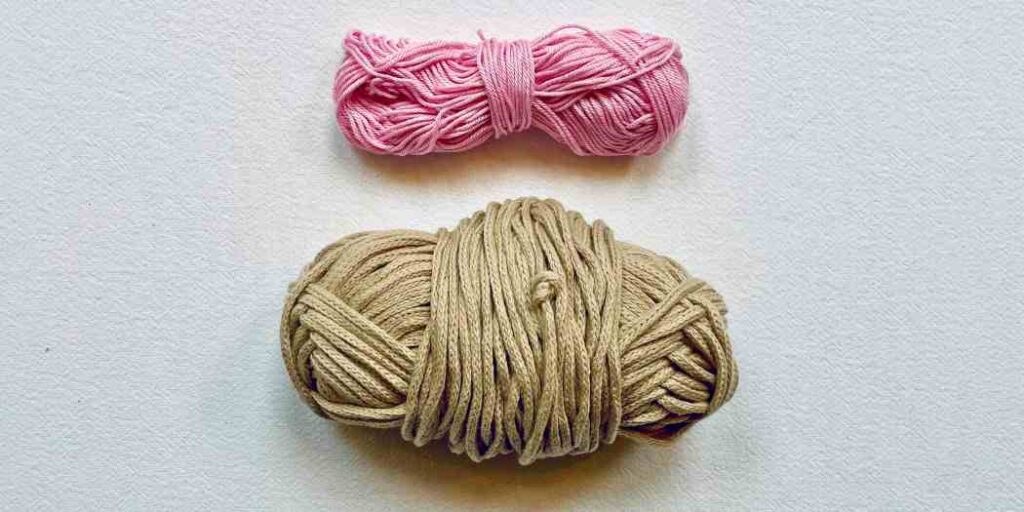
Great for making: Almost anything, if you pick the right one.
Avoid using it for: Swimwear that’s actually going to get wet – cotton yarns will sag.
Take care using it for: Garments made to a formula until you reach the right size, rather than a counted pattern (eg. hexagon cardigans and some top down sweater designs). Cotton yarns typically shrink by 5 – 10% the first time they’re washed. A counted pattern ought to account for this for you, but for something like a hexi-cardi, you’ll need to account for it yourself, that is, make it 5-10% larger than you want it to end up.
Bamboo
Bamboo has a lot of the same properties as cotton, but it’s more sustainable to produce. It’s usually added to cotton yarns, or mixed with nylon. It’s very lightweight and breathable for making summer tops, but some crocheters find it a little too smooth and slippery to work with – it’s definitely an acquired taste.
Great for making: Lightweight sweaters and summer tops.
Avoid using it for: Your first crochet project.
Linen and silk
Linen and silk are something you don’t generally buy unless you already have a project in mind which specifically calls for them. They usually come with a premium price tag, so you’re not going to end up with it by accident, or use it for any sort of experimental crochet ideas.
Linen is spun from fibers inside the stems of flax plants (which also give us flaxseed). It’s lightweight and breathable, so it’s perfect for making summer tops. Unfortunately, it’s also famously fickle to work with, and getting perfectly even tension or straight hemlines is close to impossible. But if you can embrace the perfectly imperfect, it does soften and drape beautifully with age, and it will last for decades.
Silk, meanwhile, is spun from the cocoons that surround silkworm larvae. Since this is an animal welfare concern for some crocheters, vegan friendly alternatives have started to crop up in recent years, including banana silk, eucalyptus silk, and bamboo silks. Like linen, silk is exceptionally hardwearing, and feels cool to wear on hot days.
Great for making: Summer clothes, lightweight shawls
Avoid using it for: Blankets
Step 3: What weight?
In most crochet patterns, if they make one yarn recommendation at all, it will be about what weight to use. Which makes sense, because it determines what size your finished project will be! But if you’re embarking on a project without a fixed pattern – for example a simple stripey scarf, or a blanket made out of granny squares, then you’re next decision after finding a fiber is choosing what yarn weight to use.
Yarns can be arranged in a scale of 8 weight categories, from lace to jumbo:
- Lace
- Superfine
- Fine
- Light
- Medium
- Bulky
- Super bulky
- Jumbo

Lace yarns
The lightest category of yarns. Honestly, if you’re not sure what yarn to use, you don’t want to choose this one. The people who use this know what they’re doing. And that could still be you, but probably not today.
Hook size: B1 or smaller (2.25mm or less)
Super fine and fine yarns
These include fingering weight, sock weight, sport weight. Many of them are also described as ‘4-ply’ on the wrapper, which will be significant in a moment. They’re popular for small projects like socks and amigurumi, and lightweight summer garments. They’re also the traditional choice for many shawl patterns.
Hook size: B1 – 7 (2.25 – 4.5mm)
Light yarns
This category includes most DK yarns, and some worsted yarns. DK stands for ‘double knitting’, because it is spun from 8 strands, making it 8-ply vs the 4-ply (super)fine yarns. Worsted yarns on the other hand are 10-ply, but if the fibers are very fine, they can still fall into the lightweight category. This is a versatile weight class, used for all types of projects.
Hook size: 7 – I9 (4.5 – 5.5mm)
Medium yarns
Medium yarns include most worsted yarns, and also aran yarns. They’re both 10-ply, but the strands are spun together differently, so that worsted yarns are narrower and aran yarns are slightly bulkier. But there’s not a lot in it, and it’s increasingly common for the two terms to be used interchangeably! It’s another versatile weight category, used in all types of crochet patterns.
Hook size: I9 – K10.5 (5.5 – 6.5mm)
Bulky yarns
Also known as chunky yarns, these can be 12 or even 16-ply thick. They’re popular for making sweaters, because their weight means they work up fast. They’re also a good choice for blankets, throw pillow covers, and winter accessories like hats and scarves.
Hook size: K10.5 – M13 (6.5 – 9mm)
Super bulky yarns
A.K.A. super chunky yarns. Even though it’s nearly as heavy as yarn can get, this weight category is home to yarns for a wide range of projects. Super bulky wool yarn is popular for hats, snoods and headbands. Cottons are perfect for turning into storage baskets or even rugs. And the polyester chenilles popular for making amigurumi plush toys are also mostly this weight.
Hook size: M13 – Q (9 – 16mm)
Jumbo yarns
Last but not least, a catch-all category for every yarn too big to work on a size Q hook! Jumbo yarns are mostly chenilles, but some cotton macrame cords being repurposed for crochet would also count as jumbo weight. Like lace weight yarns, you don’t typically end up using these unless you planned it from outset.
Step 4: Apply your budget
The next step after filtering the yarns on a website or a yarn store shelf by weight and fiber, is to remove the options outside of your budget.
In general, you get what you pay for with yarns. The cheapest options are likely to be lower quality, perhaps less durable, or may have been spun in factories with poor working conditions. At the top end, if you’re lucky enough to be able to afford them for a special project, there will likely be some premium yarns. These might come from small-scale, artisan spinners, be hand dyed in unique colors, or contain luxury fibers like cashmere. And the middle, there’ll (hopefully) be a choice of decent yarns at a range of price points, with minor differences between them.
Step 5: The little extras
Right now, you might already have whittled the possibilities down to just small handful of yarns. But if you’re still overwhelmed by options, here are some more criteria you might apply:
- Machine washability. This is particularly relevant when it comes to sifting between pure wool yarns. Projects like hats don’t need washing much, but sweaters (especially for kids) do.
- Anti-pilling. Some pilling in high friction areas (like in the armpits of sweaters) is inevitable, but the more tightly plied a yarn is, the better it will resist it. By contrast, single ply and loosely plied yarns will pill almost as soon as you look at them. Several of the larger brands have specific anti-pilling yarns now.
- Dye method. Most yarns are processed and dyed on a large scale using industrial machinery, but for extra special projects, hand dyed yarns add an extra layer of craftsmanship.
- Is it in a skein or a ball? The yarns below have been twisted into skeins. They’re cheaper for yarn makers to transport, and make it easier to see the dye distribution on patterned yarns. But, this yarn needs to be wound into balls before I start using it, or there will be an almighty tangle. You can wind skeins into balls by hand (it’s a workout!), or using a ball winder. If you’re not interested in the hassle of either option, choose a yarn which is sold in balls, not skeins.

Making your final choice
Once you’re able to say that you want to crochet an infinity scarf (for example) in red DK yarn, either spun from pure wool or a wool/acrylic blend, and you’ve refined the options to just those in your budget, then made a practical choice to focus on machine-washable yarns, it’s likely you’ll only have one or two left to choose from. Then you can choose the exact shade of red which most calls out to you, or the yarn with the best reviews from previous buyers, or you might get lucky and discover a premium yarn that’s normally outside your budget has been discounted. Either way, making that final choice should be pretty fun and easy now you’ve overcome the initial overwhelm of options!
For another perspective on making your final choice, here’s Lucy’s take on the same subject, and advice for making sure you never suffer yarn buyer’s remorse!
The one type of yarn you should never use for crochet
Finally, a word on the one yarn that sucks for all crochet projects of any type.
Boucle. It’s awful. All those little loops will get snagged on your hook and impede your progress, and you will end up throwing the whole lot across the room in a rage. Just don’t.
Yarn guide complete!
And that’s everything you need to know about choosing and using yarn for crochet projects! The possibilities really are endless, which is part of the fun. And the more projects you make, the more confident you’ll become experimenting with unusual choices. Happy crocheting!
